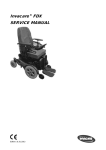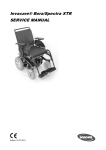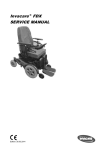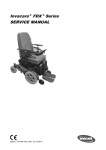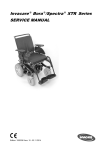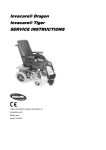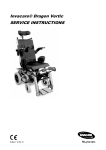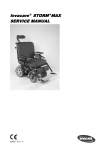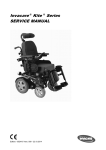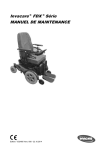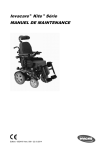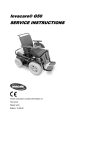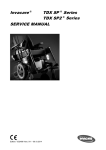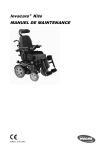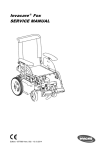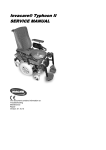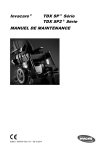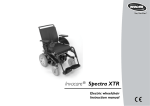Download Invacare® FDX SERVICE MANUAL
Transcript
Invacare® FDX SERVICE MANUAL These instructions contain information about: testing work repair work Edition:14.07.10 Mobitec Mobilitätshilfen GmbH Herzog Odilostrasse 101 Fax: A-5310 Mondsee @: [email protected] Austria @: [email protected] +43 - 6232 - 55 35 0 +43 - 6232 - 55 35 4 WWW: www.mobitec-austria.com Invacare® n.v. Autobaan 22 Fax: B-8210 Loppem (Brugge) @: Belgium WWW: Mobitec Rehab AG +41 - (0)61 - 48 77 08 0 Benkenstraße 260 Fax: +41 - (0)61 - 48 77 08 1 CH-4108 Witterswil @: [email protected] Switzerland @: [email protected] +32 - (0)50 - 83 10 10 +32 - (0) 50 - 83 10 11 [email protected] www.invacare.be WWW: www.mobitec-rehab.ch Invacare Aquatec Alemannenstraße 10 Fax 88316 Isny @: [email protected] Deutschland WWW: www.invacare-aquatec.de Invacare® A/S (Kundeservice): +45 - (0)36 - 90 00 00 Sdr. Ringvej 37 Fax (Kundeservice): +45 - (0)36 - 90 00 01 DK-2605 Brøndby @: Danmark WWW: Invacare® SA : +34 - (0)972 - 49 32 00 c/ Areny, s/n Fax: +34 - (0) 972 - 49 32 20 Poligon Industrial de Celrà @: 17460 Celrà (Girona) WWW: 0 75 62 / 7 00 - 251 08 00 / 6 73 81 72 [email protected] www.invacare.dk [email protected] www.invacare.es ESPAÑA 2 Invacare® Poirier SAS : +33 - (0)247 - 62 64 66 Route de St Roch Fax: +33 - (0)247 - 42 12 24 F-37230 Fondettes @: France WWW: Invacare® Ltd (Customer Service): Pencoed Technology Park Fax (Customer Service): +44 - (0)1656 - 776 220 Pencoed @: [email protected] Bridgend CF35 5HZ @: [email protected] United Kingdom WWW: www.invacare.co.uk [email protected] www.invacare.fr +44 - (0)1656 - 776 222 Invacare Mecc San s.r.l. +39 - 0445 - 38 00 59 Via Dei Pini, 62 Fax: +39 - 0445 - 38 00 34 I - 36016 Thiene (VI) @: ITALIA WWW: Invacare Ireland Ltd. +353 - 18 10 70 84 Unit 5 Seatown Business Campus Fax: +353 - 18 10 70 85 Seatown Rd, Swords @: [email protected] [email protected] www.invacare.it County Dublin Ireland Invacare® AS (Kundeservice): +47 - (0) 22 57 95 10 Grensesvingen 9 Fax (Kundeservice): +47 - (0)22 57 95 01 Postboks 6230 @: N-0603 Oslo WWW: [email protected] www.invacare.no Norge Invacare® B.V. : +31 - (0)318 - 69 57 57 Celsiusstraat 46 Fax: +31 - (0) 318 - 69 57 58 NL-6716 BZ Ede @: The Netherlands WWW: Invacare® PORTUGAL Lda : +351-225105946 Rua Senhora de Campanhã 105 Fax: +351-225105739 P-4369-001 Porto @: PORTUGAL WWW: [email protected] www.invacare.nl [email protected] www.invacare.pt 3 Återförsäljare: (Kundtjänst): +46 - (0) 8 761 70 90 Invacare® AB Fax (Kundtjänst): +46 - (0) 8 761 81 08 Fagerstagatan 9 @: [email protected] S-163 91 Spånga @: [email protected] Sverige WWW: Tillverkare: Invacare Deutschland GmbH Kleiststraße 49 D-32457 Porta Westfalica Deutschland www.invacare.se MÖLNDAL +46 - (0) 31 – 86 36 00 Fax: +46 - (0) 31 – 86 36 06 @: [email protected] LANDSKRONA +46 - (0) 418 – 285 40 Fax: +46 - (0) 418 – 180 89 @: [email protected] OSKARSHAMN +46 - (0) 491 – 101 40 Fax: +46 - (0) 491 – 101 80 @: 4 [email protected] Table of contents Chapter 1 INTRODUCTION Page 8 1.1 General information 8 1.2 Notes on transport 8 1.3 Definition and representation of information and safety information in this manual 9 1.4 Hazard symbols and symbols used 10 1.5 Images in this manual 11 2 SAFETY AND FITTING INSTRUCTIONS 12 2.1 Before any inspection or repair work 12 2.2 Personal safety equipment 12 2.3 General safety information and information about fitting / removal 12 3 TIGHTENING TORQUES 14 4 ARRANGEMENT OF SUB-ASSEMBLIES AND COMPONENTS 15 4.1 Overview 15 4.2 Electronic modules 4.2.1 ACS II PMB70 / ACS II PMB70L electronic module 4.2.2 ACS II PMA90L electronic module 4.2.3 Actuator module ACT 4.2.3.1 Actuator module ACT2 4.2.3.2 Actuator module ACT 4 4.2.4 Lighting circuit board 17 18 18 18 18 19 19 4.3 20 Remotes 5 MAINTENANCE PLAN (ONCE A YEAR) 22 6 OPERATIONAL FAULTS 24 6.1 Drive fault diagnosis 25 6.2 Diagnosis of charging device faults 29 5 7 TEST PROCEDURES 30 7.1 Testing the motor 30 7.2 Testing the electro-mechanical parking brake 31 8 REPAIR WORK 8.1 8.1.1 8.1.2 8.1.3 8.1.4 Covers Open front cover Opening the rear cover Opening the lateral cover Opening the cover of the rear wheel cantilever arm 33 33 33 34 35 38 8.2 Electronic modules 8.2.1 Replacing remotes 8.2.2 Replacing electronic modules 8.2.3 Replacing the G-Trac module 8.2.4 Drive program selection after component replacement 8.2.4.1 Profile selection with G90A remote 8.2.4.2 Profile selection with remote REM A or REM B 8.2.4.3 Profile selection with remote REM 550 39 39 39 42 44 44 45 46 8.3 Updating the driving program 47 8.4 8.4.1 8.4.2 8.4.3 8.4.4 8.4.5 Batteries, cables & battery chargers Removing the batteries Replacing batteries / replacing battery cables How to handle damaged batteries correctly Replacing the main fuse Checking the cables 48 48 51 53 54 55 8.5 Lighting system 8.5.1 Replacing light bulbs in the front (conventional lighting system) 8.5.2 Replacing the LEDs in the front (LED lighting system) 8.5.3 Replacing the complete head lamp assembly (conventional lighting system) 8.5.4 Replacing the head lamps completely (LED lighting system) 8.5.5 Replacing the head lamp bracket (conventional lighting system) 8.5.6 Replacing a light bulb in the rear (conventional lighting system) 8.5.7 Replacing the LEDs in the rear (LED lighting system) 8.5.8 Replacing the complete tail lamp assembly (conventional lighting system) 8.5.9 Replacing the tail lamp bracket (conventional lighting system) 8.5.10 Replacing the tail lamps completely (LED lighting system) 57 57 57 58 60 62 63 63 64 66 67 8.6 68 Seat / seat frame (without lifter) 8.7 Replacing the tilt module / lifter module 8.7.1 Replacing the tilt module (without lifter) 8.7.2 Replacing the lifter / tilt module 8.7.3 Replacing the tilt actuator 8.7.4 Replacing the lifter actuator 8.7.4.1 Method 1 - uninstalling the lifter actuator with the lifter raised 8.7.4.2 Method 2 - uninstalling the lifter actuator with the lifter lowered 6 71 71 74 78 80 80 82 8.8 8.8.1 8.8.2 8.8.3 8.8.4 8.8.5 Centre-mounted legrest (electric & manual) Replacing the manually operated centre-mounted legrest Replacing the electrically operated centre-mounted legrest Replacing an electric legrest actuator Replacing the calf plate on the centre-mounted legrest (electric & manual) Replacing the foot plate on the centre-mounted legrest (electric & manual) 86 86 88 90 92 93 8.9 Replacing the restraining belt 94 8.10 Replacing the anti-tipper wheels 95 8.11 Rear wheels 8.11.1 Replacing a rear wheel 8.11.2 Replacing a rear wheel fork 8.11.3 Adjusting the wheel fork 96 96 97 99 8.12 Drive wheels 8.12.1 Replacing a drive wheel 8.12.2 Replacing a tyre 8.12.3 Replacing a drive wheel hub 101 101 102 103 8.13 Drive unit 8.13.1 Replacing the motor / gearbox unit 8.13.2 Replacing or rotating the motor / gearbox unit sealing ring 8.13.3 Replacing the motor / gearbox coupling 8.13.4 Replacing the carbon brushes 8.13.5 Running the motor in 105 105 107 108 110 112 8.14 Replacing the motor / gearbox fixation and rear wheel cantilever arm 113 8.15 Replacing the spring in the rear 115 8.16 Fixation rings 8.16.1 Replacing a front fixation ring 8.16.2 Replacing a rear fixation ring 117 117 118 8.17 119 Replacing the battery boxes 7 1 Introduction 1.1 General information ● Service and maintenance work must be carried out taking this service manual into account. ● It is imperative that you observe safety information. ● Information about operation or about general maintenance and care work on the mobility aid should be taken from the operating manual. ● You can find information about ordering spare parts in the spare parts catalogue. ● Only use original Invacare® spare parts. The guarantee will become invalid if other spare parts are used! ● We reserve the right to make any alterations on the grounds of technical improvements. ● The mobility aid may only be maintained and overhauled by qualified personnel. ● The minimum requirement for service technicians is suitable training, such as in the cycle or orthopaedic mechanics fields, or sufficiently long-term job experience. - Experience in the use of electrical measuring equipment (multimeters) is also a requirement. - Special Invacare® training is recommended. ● Alterations to the mobility aid which occur as a result of incorrectly or improperly executed maintenance or overhaul work lead to the exclusion of all liability on the side of INVACARE. ● If you have any problems or questions please contact Invacare® Service. 1.2 Notes on transport 8 ● If the mobility aid has to be shipped back to the manufacturer for major repairs, you should always use the original packaging for transport. ● Please attach a precise description of the fault. 1.3 Definition and representation of information and safety information in this manual Different types of information and signal words are used throughout this manual. HAZARD! The signal word "HAZARD!" refers to immediate hazards. ● The following lines in italics refer to actions which serve to avoid such hazards. WARNING! The signal word "WARNING!" refers to possibly-occurring hazards which can lead to death or serious injuries if they are not avoided. ● The following lines in italics refer to actions which serve to avoid such hazards. ATTENTION! The signal word " ATTENTION!" refers to possibly-occurring hazards which can lead to minor injuries and/or material damage if they are not avoided. ● The following lines in italics refer to actions which serve to avoid such hazards. CAUTION! The signal word "CAUTION!" refers to hazards which could lead to material damage if they are not avoided. ● The following lines in italics refer to actions which serve to avoid such hazards. Note The signal word "Note" is used to denote general information which simplifies the handling of your product and refers to special functions. 9 1.4 Hazard symbols and symbols used Different types of hazard symbols and symbols are used throughout this manual. General hazards This symbol warns you of general hazards! ● Always follow the instructions to avoid injury to the user or damage to the product! BURN HAZARD! This symbol warns you of the danger of chemical burns, for example due to the discharge of battery acids! ● Always follow the instructions to avoid injury to the user or damage to the product! DANGER OF CRUSHING! This symbol warns you of crushing hazards due to inattentive working with heavy components. ● Always follow the instructions to avoid injury to the user or damage to the product! EXPLOSION HAZARD! This symbol warns you of an explosion hazard, which can be caused by excessive tyre pressure in a pneumatic tyre. ● Always follow the instructions to avoid injury to the user or damage to the product! Wear safety shoes The symbol refers to the requirement for wearing safety shoes. ● Wear standardised safety shoes during all work. Wear eye protection This symbol refers to the requirement for wearing eye protection, for example when working with batteries. ● Wear eye protection when this symbol is shown. Wear safety gloves This symbol refers to the requirement for wearing safety gloves, for example when working with batteries. ● Wear safety gloves when this symbol is shown. Note This symbol identifies general information which is intended to simplify working with your product and which refers to special functions. Requirements: ● This symbol identifies a list of various tools, components and items which you will need in order to carry out certain work. Please do not attempt to carry out the work if you do not have the listed tools available. Always dispose used or damaged batteries correctly The symbol refers to information for the correct disposal of used or damaged batteries. 10 1.5 Images in this manual The detailed images in this manual are given digits to identify various components. Component numbers in text and operational instructions always relate to the image directly above. 11 2 Safety and fitting instructions These safety instructions are intended to prevent accidents at work, and it is imperative that they are observed. 2.1 Before any inspection or repair work ● Read and observe this repair manual and the associated operating manual! ● Observe the minimum requirements for carrying out the work (see chapter entitled „General information)! 2.2 Personal safety equipment Safety shoes The mobility device, and some of its components, are very heavy. These parts can result in injuries to the feet if they are allowed to drop. ● Wear standardised safety shoes during all work. Eye protection It is possible that battery acid can be discharged when working on defective batteries or when handling batteries improperly. ● Always wear eye protection when working on any defective or possibly defective batteries. Safety gloves It is possible that battery acid can be discharged when working on defective batteries or when handling batteries improperly. ● Always wear acid-proof safety gloves when working on any defective or possibly defective batteries. 2.3 General safety information and information about fitting / removal WARNING: Danger of crushing! Various components such as the drive unit, batteries, seat etc are very heavy. This results in injury hazards to your hands! ● Please note the high weight of some components! This applies especially to the removal of drive units, batteries and the seat. WARNING! Injury hazard if the vehicle starts moving unintentionally during repair work! ● Switch the power supply off (ON/OFF key)! ● Engage the drive! ● Before raising the vehicle, secure the wheels by blocking them with wedges! ATTENTION! Fire and burn hazard due to electrical short-circuit! ● The mobility device must be completely switched off before removal of voltage-carrying components! To do this, remove the batteries. ● Avoid short-circuiting the contacts when carrying out measurements on voltage-carrying components! 12 ATTENTION! Injury hazard and danger of damage to vehicle due to improper or incomplete maintenance work! ● Use only undamaged tools in good condition. ● Some moving parts are mounted in sockets with PTFE coating (Teflon™). Never grease these sockets! ● Never use "normal" nuts instead of self-locking nuts. ● Always use correctly-dimensioned washers and spacers ● When reassembling, always replace any cable ties which were cut during dismantling. ● After completing your work / before renewed start-up of the mobility device, check all connections for tight fitting. ● After completing your work / before renewed start-up of the mobility device, check all parts for correct locking. ● Only operate the vehicle with the approved tyre pressures (see technical data). ● Check all electrical components for correct function. Please note that incorrect polarity can result in damage to the electronics. ● Always carry out a trial run at the end of your work. Note Mark all current settings for the mobility aid (seat, armrests, backrest etc.), and the associated cable connecting plugs, before dismantling. This makes reassembly easier. All plugs are fitted with mechanical safety devices which prevent release of the connecting plugs during operation. To release the connecting plugs the safety devices must be pressed in. When reassembling ensure that these safety devices are correctly engaged. WARNING! Any changes to the drive program can affect the driving characteristics and the tipping stability of the vehicle! ● Changes to the drive program may only be carried out by trained Invacare® specialist dealers! ● Invacare® supplies all mobility aids with a standard drive program ex-works. Invacare® can only give a warranty for safe vehicle driving behaviour - especially tipping stability - for this standard drive program! 13 3 Tightening torques The tightening torques stated in the following list are based on the thread diameter for the nuts and bolts for which no specific values have been determined. All values assume dry and de-greased threads. Thread M4 M5 M6 M8 M10 M12 Tightening torque in Nm ±10% 3 Nm 6 Nm 10 Nm 25 Nm 49 Nm 80 Nm M14 M16 120 Nm 180 Nm CAUTION! Damage can be caused to the mobility device due to improperly tightened screws, nuts or plastic connections. ● Always tighten screws, nuts etc to the stated tightening torque. ● Only tighten screws or nuts which are not listed here fingertight. 14 4 Arrangement of sub-assemblies and components 4.1 Overview In the rear under the seat: Electronic modules The electronic modules are located under the rear cover: (1) – Electronic module (2) – Actuator module (optional) (3) – Lighting circuit board (optional & not shown in the illustration) The electronic modules that are installed are described in chapter 4.2. In the front under the seat: (1) – Actuator module (optional) (2) – Lifter actuator (optional) (3) – Tilt actuator (optional) 15 On the right, next to the spring seat: (1) – G-Trac module (optional) 16 4.2 Electronic modules Various different types of electronic modules can be installed in the wheelchair. Before you connect components of the wheelchair such as adjustment motors or actuators to the electronic module, make sure you know exactly which electronic module is installed. The following table provides an overview. Electronic modules Designations Remotes ACS II PMB70 ACS II PMB70L ACS II PMA90LG G90A REM A REM B REM 550 REM24 Remarks ACS II with actuator module ACT The actuator module is optional. Actuator module ACT The actuator module is optional. Lighting circuit board The lighting circuit board is optional. G-Trac module The G-Trac module is optional 17 4.2.1 ACS II PMB70 / ACS II PMB70L electronic module Connections 1) Battery 24V 2) Bus cable (to remote or ACT) 3) Bus cable (to remote or ACT) 4) Motor M1 5) Light 6) Motor M2 4.2.2 ACS II PMA90L electronic module Connections 1) Battery 24V 2) Cable to G-Trac module (GYRO) 3) Bus cable (to remote or ACT) 4) Motor M1 5) Light 6) Motor M2 4.2.3 Actuator module ACT Various types of adjustment motors, also called actuators, can be installed on the wheelchair. These actuators are either connected directly to the electronic module or to a separate actuator module. The actuator module is connected to the electronic module via a bus cable. 4.2.3.1 Actuator module ACT2 Connections 1) ACI* 2) Bus cable (to remote or ACT) 3) Bus cable (to remote or ACT) 4) Adjustment motor/actuator - channel 2 5) Adjustment motor/actuator - channel 1 * The ACI connection serves to limit the movement of an actuator or to reduce velocity. 18 4.2.3.2 Actuator module ACT 4 Connections 1) ACI* 2) Bus cable (to remote or electronic module) 3) Bus cable (to remote or electronic module) 4) Actuator - channel 4 5) Actuator - channel 3 6) Actuator - channel 2 7) Actuator - channel 1 * The ACI connection serves to limit the movement of an actuator or to reduce velocity. 4.2.4 Lighting circuit board The connections of the lighting circuit board are located directly on the board. 19 4.3 Remotes Various types of remotes can be installed on the wheelchair. Before you connect components of the wheelchair such as adjustment motors or actuators, make sure you know exactly which remote is installed. The following table provides an overview. Remotes 20 Designations Remarks REM G90A Can be connected to - ACS II PMB70 - ACS II PMB70L - ACS PMA90LG power modules. REM A Can be connected to - ACS II PMB70 - ACS II PMB70L - ACS PMA90LG power modules. REM B Can be connected to - ACS II PMB70 - ACS II PMB70L - ACS PMA90LG power modules. Remotes Designations Remarks REM 550 Can be connected to - ACS II PMB70 - ACS II PMB70L - ACS PMA90LG power modules. 21 5 Maintenance plan (once a year) Component Check for Measures Restraining belt ● Damage to the restraining belt ● If the belt is damaged, replace it. ● If the belt is damaged, replace it. ● If the arm pad is damaged, replace it. ● Tighten screws ● Function of the belt buckle Armrests Side Parts ● Damage to the armrests ● Fixation of the armrests ● Damage to the side parts See chapter 8.9 See chapter 8.9 ● Replace the side partsif damaged ● Fixation screws of the side parts ● Damage to the Electric backrest backrest (if ● Seams available) ● Fastening ● Check cable ● Check function ● Check fastenings, Frame (chassis) welding seams and / battery battery box compartment ● Tighten screws ● Check tight fit of the drive wheels and axial run out ● Check tight fit of steering wheels, Check required motor-to-body clearance and axial run out ● Tyres ● Adjust, replace wheel hubs See chapter 8.12.1 and 8.12.3 ● Replace wheels, wheel fork or wheel bearing See chapter 8.11 ● Repair or replace if damaged ● Repair or replace if damaged ● Replace wheels, wheel fork or wheel bearing ● Check motors See chapter 8.12.2 Wheel suspension and wheels ● Check suspension ● Check directional stability Drive units, coupling mechanism 22 Remarks ● Motors ● Check functions during drive operation and when pushing ● Check coupling mechanism ● Replace parts if damaged ● Tighten screws ● Replace cable or motor if necessary ● Tighten screws ● Replace parts if necessary See chapter 8.15 See chapter 8.11 and 8.12 See chapter 7.1 ● Check the carbon See chapter 8.13.1 brushes, replace if and 8.13.4 necessary ● Replace motor if necessary ● Tighten screws/nuts, adjust or replace if necessary 9 Component Brakes Check for Measures ● Motor brake check ● Check the motor brake ● Tighten, replace if necessary See chapter 8.8 & the User Guide ● Replace cable if necessary See chapter 8.8 & the User Guide ● Check welding seams, locking devices, screws and foot plates ● Check cable Electric legrests ● Check contacts (if available) ● Check functions ● Check cable Lighting (if ● Check function available) Legrests Battery box Batteries Remote / electronic module 9 See chapter 7.2 ● If necessary, replace light or cable ● Check battery box ● Replace if and fastening belt for necessary damage ● Check batteries for ● Replace batteries damage if necessary See chapter 8.4.1 and 8.4.3 ● Check battery voltage ● Check battery voltage ● Charge batteries ● Charge batteries See instruction manual ● Check contacts and terminal clamps ● Clean contacts and terminal clamps See the safety notes in chapter 8.4.1 and 8.4.3 for information on correctly handling batteries See chapter 8.5 ● Remote, status display flashing ● Fixations ● ● ● Drive programme Remarks ● ● Analyse the error / See chapter 6 flash code ● Tighten fixations, replace if necessary Cables and plug-in ● Check all cables connections and plug-in connections for secure fit, replace if necessary Joystick function ● Replace joystick if necessary ● Replace remote if necessary ● Check all cables Power supply and plug-in connections for secure fit, replace if necessary Check the version of ● Update the See chapter 8.3 the programme in software if a the driving newer version is electronics. available. 23 6 Operational faults The various electronics modules can be fitted in connection with differing remotes in the mobility aid. Rectification of operational faults is dependent on the electronics module fitted. The electronics modules used are described in Chapter 4.2. Note The tables for rectification of operational faults listed in the following chapters are only an excerpt from the original manufacturer's manuals. You can obtain the original manuals from Invacare®. If you have problems with the mobility aid, please proceed as follows: ● First assess the possible cause of the problem using the following table. ● Check the remote status display. Evaluate the error code. ● Carry out the necessary checks and repairs as recommended in the following table. 24 6.1 Drive fault diagnosis PROBLEM OTHER SYMPTOMS Mobility aid The remote will not status display start illuminates normally and displays blink code 5/6. POSSIBLE CAUSE SOLUTION Documentation Drive motors disengaged Engage drive motors See operating manual Replace batteries See chapter 8.4.1. Pre-charge batteries See operating manual Remote status Batteries display does not defective illuminate Completely discharge battery Power supply to Check master fuse See chapter 8.4.4. remote Check cables See chapter 8.4.5. interrupted between the modules for loose connections and damage Remote status display blinking Mobility aid None judders in drive mode Remote defective Replace remote See chapter 8.2.1. Various causes Assess error code See chapter 6.2. Batteries defective (unstable voltage) Replace batteries See chapter 8.4.1. Drive motor(s) defective Replace motor(s) See chapter 8.13.1. Replace carbon brushes See chapter 8.13.4. Change programming to synchronise motors. See chapter 8.3. Mobility aid None pulls to left or right Drive motors running asymmetrically None Error message does not go out Bad connections Check all See chapter 8.4.5. connecting cables. Motors stop None and start irregularly Motor brake defective Measure internal resistance of brakes, replace motor if defective. Voltage decline Stop journey and allow electronics to cool down. See chapters 7.2 and 8.13.1 25 PROBLEM OTHER SYMPTOMS POSSIBLE CAUSE SOLUTION Motor runs but loses power None High motor loading causes electronics module to decrease voltage Stop journey and allow electronics to cool down. Motors stop None and do not start again High motor loading causes electronics module to decrease voltage Leave mobility aid switched on and allow electronics module to work. Charge batteries overnight with mobility aid switched on. None Fuse burnt out Check cabling and See chapters 8.4.5 and replace fuse 8.4.4 None Motor defective Check carbon brushes and replace if necessary See chapter 8.13.4. Measure internal resistance of motor, replace motor if defective. See chapters 7.1 and 8.13.1 None Motors lose None power during journey Motor judders or runs irregularly, or only one motor runs 26 None Electronics module defective Documentation Replacing the See chapter 8.2.2. electronics module Bad connections Switch mobility aid See chapter 8.4.5. off, wait 10 seconds, switch mobility aid on again. Check all cabling. Carbon brushes Check carbon worn brushes and replace if necessary See chapter 8.13.4. Clutch(es) defective Replace clutch See chapter 8.13.3. Bearing defective Replacing the motor See chapter 8.13.1. Collector defective Measure internal resistance of motor, replace motor if defective. See chapters 7.1 and 8.13.1 PROBLEM OTHER SYMPTOMS POSSIBLE CAUSE Motors do not run None Bad connections Check all cabling. Motor makes clicking noise Scraping noise or motor blocked SOLUTION Documentation See chapter 8.4.5. Fuse burnt out Check cabling and See chapters 8.4.5 and replace fuse 8.4.4 Batteries defective Replace batteries See chapter 8.4.1. Cabling to electronics module or joystick defective check cabling See chapter 8.4.5. Electronics module defective Replacing the See chapter 8.2.2. electronics module Corroded contacts Water, salt or urine has penetrated Check cabling, replace if necessary. See chapter 8.4.5. None Clutch(es) defective Replace clutch See chapter 8.13.3. Bearing defective Replacing the motor See chapter 8.13.1. Collector defective Measure internal resistance of motor, replace motor if defective. See chapters 7.1 and 8.13.1 Clutch(es) defective Replace clutch See chapter 8.13.3. Bearing defective Replacing the motor See chapters 8.13.1 and 8.13.3 Transmission defective Replace transmission. See chapters 8.13.1 and 8.13.3 Transmission defective Replace transmission. See chapters 8.13.1 and 8.13.3 Drive wheel loose Tighten drive See chapter 8.12.1. wheel, secure bolts with Loctite if necessary Sealing ring on drive shaft defective Replace transmission if sealing ring defective. See chapters 8.13.1 and 8.13.3 Check carbon brushes for oil wetting, replace motor if brushes wet See chapters 8.13.1, 8.13.3 and 8.13.4 None Transmissi on makes clicking noise None Transmissi on losing oil None 27 PROBLEM OTHER SYMPTOMS POSSIBLE CAUSE Irregular running None Drive shaft Check drive shaft, See chapters 8.13.1 and movable or bent replace 8.13.3 transmission if defective. Parts lost None Parts lost Reattach parts once found. Batteries not being charged None Fuse burnt out, cable defective Check cabling and See chapters 8.4.5 and replace fuse 8.4.4 Batteries defective Replace batteries See chapter 8.4.1. LEDs blinking Charging unit on charging unit defective Replace charging unit See charging unit operating manual None One of the batteries could be defective Replace batteries See chapter 8.4.1. Remote defective Replace remote See chapter 8.2.1. Batteries defective Replace batteries See chapter 8.4.1. Remote shows Lighting / Replace lighting / blinking "E" 1 or actuator module actuator module blink code 2 2 defective Status diode on lighting/actuator module does not go out even if the remote has been switched off or disconnected See chapter 8.2.2. Short charging period Mobility aid None runs too slowly Actuator does not react None 1 Only applies to remote SD24 2 All remotes except SD24 28 SOLUTION Cable disconnected or damaged Safeguard cable connection, replace cable if necessary Electrical adjusting motor defective Check adjusting motor Remote defective Replace remote Documentation See chapter 8.4.5. See chapter 8.2.1. 6.2 Diagnosis of charging device faults SYMPTOM No LEDs illuminating on battery charger POSSIBLE CAUSE SOLUTION Charging device not connected to mains supply. Ensure that the battery charger has been plugged in. No mains supply Check the mains supply with a voltmeter. Defective mains supply cable. Check the mains supply cable. Replace damaged cables or send the battery charger to Invacare® Service for repair. LEDs are burnt out Send the battery charger to Invacare® Service for repair. An internal fuse might be burnt Send the battery charger to out. Invacare® Service for repair. Batteries do not charge Fuse on mobility aid has burnt out. Check mobility aid fuses. See chapter 8.4.4. Battery charger not connected Ensure that the battery to mobility aid. charger has been connected to the mobility aid. No mains supply Check the mains supply with a voltmeter. Defective mains supply cable. Check the mains supply cable. Replace damaged cables or send the battery charger to Invacare® Service for repair. Battery charger could be defective. Use a battery charger which you know is working properly to charge the batteries. Send the defective battery charger to Invacare® Service for repair. Battery voltage is too low to operate mobility aid. Replace the batteries. See chapter 8.4.1. 29 7 Test procedures 7.1 Testing the motor Requirements: ● Phillips screwdriver size 2 ● digital multimeter with resistance measurement ● Remove the rear panel as described in Chapter 8.1.2. ● Pull the motor plug (1) out of the electronics module. ● Connect the digital multimeter to the motor plug contacts (3) and measure the resistance between the contacts. Note A resistance of between 0.5 and 5 ohms indicates a motor ready for operation. A resistance of between 15 ohms and infinity indicates a defective motor. High resistances are normally caused by bad connections or worn carbon brushes. 30 7.2 Testing the electro-mechanical parking brake Note This test should only be carried out on mobility aids with conventional motor/transmission units. Requirements: ● Phillips screwdriver size 2 ● digital multimeter with resistance measurement ● Remove the rear panel as described in Chapter 8.1.2. ● Pull the motor plug (1) out of the electronics module. ● Connect the digital multimeter to the adjacent central motor plug contacts (3) and measure the resistance between the contacts. ● If there is a defect, replace the motor and send it to Invacare® Service for inspection or repair. 31 Note A resistance of between 40 and 80 ohms indicates an intact brake. A resistance of 0 ohms or a very high resistance (mega-ohms or infinity) indicates a short-circuit, a bad connection or a defective brake. CAUTION! Material damage can be caused to the electronics module due to short-circuits in the electro-mechanical brake. ● NEVER connect an electro-mechanical brake to an intact electronics module with a shortcircuit! ● Always replace short-circuited brakes immediately. Note A defective motor can damage the electronics module, but not the other way around. 32 8 Repair Work 8.1 Covers 8.1.1 Open front cover Removing the front cover: ● Remove the legrests. ● Loosen and remove both of the knurled head screws (1). ● Press the front cover (2) slightly upward, then pull the cover forward and off. Installing the front cover: ● Assemble the parts in reverse order. ● When installing the plastic cover, make sure that the slots on the sides (3) and the lower hooks on the cover latch onto the chassis (4). ● Tighten both knurled head screws hand-tight. 33 8.1.2 Opening the rear cover Removing the rear cover: ● Loosen and remove both of the knurled head screws (1). ● Remove the rear cover (2). Installing the rear cover: ● Assemble the parts in reverse order. ● 34 Tighten both knurled head screws hand-tight. 8.1.3 Opening the lateral cover Requirements: ● 10 mm socket wrench ● 6 mm Allen key ● Two oblong wooden blocks, at least 14 x 14 x 30 cm Removing the lateral cover: ● Remove the drive wheel, as described in chapter 8.12.1. ● Remove the front cover and the rear covers, as described in chapters 8.1.1 and 8.1.2. ● Use the 10 mm socket wrench to loosen both screws (1). ● Hold the cover firmly with one hand. ● Completely remove both screws (1) including the washers. ● Pull the cover off towards the side. ● Disconnect the plug-in connections if there are tail lights installed in the lateral cover (see illustration below). 35 Installing the lateral cover: ● 36 Connect the plug-in connections if there are tail lights installed in the lateral cover. Make sure that the markings (1 = red tail light) and (2 = yellow flasher) on the power supply cable and on the tail light plug-in connection are aligned with each other. ● Push the cover from the side between the seat and the chassis. ● Position both screws (1) including the washers and tighten the screws hand-tight. 37 8.1.4 Opening the cover of the rear wheel cantilever arm Requirements: ● 4 mm Allen key Removing the rear cover: ● Use the 4 mm Allen key to loosen and remove the hexagon socket head screw (1). ● Pull the cover up in the rear and remove it. The cover is held in place by additional Velcro fasteners. Installing the rear cover: ● Assemble the parts in reverse order. 38 8.2 Electronic modules 8.2.1 Replacing remotes Note The procedure to replace remotes is trivial and is not described in detail. However, when replacing a REM remote in connection with a DX, ACS or ACS II electronic module, please make sure to select the correct drive programme as described in chapter 8.2.4. 8.2.2 Replacing electronic modules Note When replacing a REM remote in connection with a DX, ACS or ACS II electronic module, please make sure to select the correct drive programme as described in chapter 8.2.4. Various different types of electronic modules can be installed in connection with different remotes in the wheelchair. The electronic modules that might be installed are described in chapter 4.2. The procedure to replace components is described using the ACS II electronic module with an optional lighting circuit board and optional actuator module as an example. The procedure is identical for other electronic modules. The only difference is the position of the plug-in connections. WARNING! Every alteration to the drive programme can influence vehicle handling and the tipping stability of the wheelchair! ● Alterations to the drive programme must only be carried out by authorised Invacare® dealers! ● Invacare® can only assume a warranty for the safe vehicle handling of the wheelchair – in particular tipping stability - for this standard, unaltered drive programme! Note All electronic modules are supplied with a standard drive programme. If you have performed customer-specific modifications to the drive programme, then these will need to be recreated manually after installing the new electronic module. Requirements: ● 7 mm socket wrench ● 8 mm socket wrench ● To modify a drive programme you will need: Programming software or a hand-held programming device and the installation manual, available from Invacare®. 39 Uninstalling electronic modules: ● Remove the rear cover, as described in chapter 8.1.2. 40 ● Take exact note of the positions of all cables and the sockets that they are connected to. Mark the connectors and sockets or take a photograph with a digital camera. ● The illustration shows the electronic module (1) and the optional actuator module (2). The optional lighting circuit board is not shown in the picture, but it would be installed at position (3) if it was present. ● Disconnect the plugs (1) from the electronic module and, if installed, from the optional actuator module and the optional lighting circuit board. ● Use the 8 mm socket wrench to loosen and remove the nuts (1). ● Remove the actuator module together with the mounting plate (2). ● If the actuator module is to be replaced: Use the 7 mm socket wrench and a Phillips screwdriver to loosen and remove the nuts (3). ● If the electronic module is to be replaced: Remove the electronic module. ● Replace the defective modules. Installing electronic modules: ● Install the various modules in reverse order. ● Reconnect all cable connectors to their former positions. ● If you have replaced ACS II electronic module, please select the correct drive program, as described in chapter 8.2.4. ● Update the drive program, in case a new software version is available, as described in chapter 8.3. ● Modify the drive program using the programming software as needed. ● The last step is to test all functions of the vehicle. 41 8.2.3 Replacing the G-Trac module Requirements: ● 10 mm socket wrench ● Side cutting pliers ● Cable ties Uninstalling the G-Trac module: ● Switch the electronics of the wheelchair OFF. ● Remove the front, rear and right lateral covers, as described in chapter 8.1.1, 8.1.2 and 8.1.3. The G-Trac module is located on the spring-seat of the right-hand spring. 42 ● Trace the cable of the G-Trac module (1) to the electronic module and disconnect it there. ● Pull the cable out of the wheelchair. If necessary remove any attached cable ties. ● Use the 10 mm socket wrench to loosen and remove the self-securing nuts (3) including the washers. ● Pull the G-Trac module (2) off of the carriage bolt (1) which is inserted in the spring seat. ● Replace the G-Trac module. Installing the G-Trac module: ● Assemble the parts in reverse order. ● Reconnect all cable connectors to their former positions. ● The G-Trac module must be installed with the cable pointing upwards. ● The last step is to test all functions of the vehicle. 43 8.2.4 Drive program selection after component replacement The drive program is saved in the REM remote, and also in the DX, ACS or ACS II electronics module. If one of these two components is replaced, the system must be told which of the components has not been replaced so that it knows which contains the current controller profile. Note The system allows normal usage of the mobility aid after component replacement only if the profile is selected afterwards. 8.2.4.1 44 Profile selection with G90A remote ● Connect the plug to the remote or the ACS II electronics system, respectively. ● The display (1) will indicate that you should select a profile. ● Use the arrow keys (2) to select the location where the desired controller profile is stored: I = Remote II = Electronic module ● The display will indicate which profile you have selected. ● Press the "Horn" key (3) and the "Drive Mode" key (2) and keep them pressed for 3 seconds to confirm the selection. ● The system switches itself off and starts again automatically. During this process, the selected profile is stored in the remote as well as in the electronic module. 8.2.4.2 Profile selection with remote REM A or REM B ● Plug the plug into the remote or the ACS II controller. ● LEDs (1) and (4) blink. ● Use the bottom rocker switch (5) to select where the required controller profile is saved. LED 1 = remote LED 4 = ACS II control system ● The relevant LED illuminates permanently, the other LED is off. ● Press the "Horn“ (2) and "+“ (3) buttons on the speed selection and hold them down for 3 seconds to confirm the selection. ● The system will switch itself off and restart automatically. During the process, the selected profile will be saved both in the remote and in the electronics module. 45 8.2.4.3 46 Profile selection with remote REM 550 ● Plug the plug into the remote or the ACS II controller. ● The display (2) shows that you need to select a profile. ● Use the bottom rocker switch (3) to select where the required controller profile is saved. I = remote II = electronics module ● The display will show which profile you have selected. ● Press the "Horn“ (4) and "+“ (1) buttons on the speed selection and hold them down for 3 seconds to confirm the selection. ● The system will switch itself off and restart automatically. During the process, the selected profile will be saved both in the remote and in the electronics module. 8.3 Updating the driving program The driving programs for electric wheelchairs are continually updated and improved by Invacare®. For this reason, you should check whether the version number is still up to date each time a wheelchair comes in for repairs, and also during regular inspections. If a newer version is available, the driving program must be updated. The procedure for updating the driving program is described in the user manual of the Wizard software. Note The electronic system is supplied with a standard drive program. If the driving program has been customised, you have to perform this customisation again, after installing the new driving program. WARNING! Every alteration to the drive program can influence vehicle handling and the tipping stability of the wheelchair! ● Alterations to the drive program must only be carried out by trained Invacare®-dealers! ● Invacare® can only assume a warranty for the safe vehicle handling of the wheelchair – in particular tipping stability - for unaltered standard drive programs! Requirements: ● Dynamic® Wizard software ● User manual for the Wizard software ● For further information on other requirements - such as the minimum system configuration of the PC to be used for programming, necessary programming cables - see the user manual of the Wizard software. You find the latest version of the user manual in the download area on http://www.dynamiccontrols.com/. 47 8.4 Batteries, cables & battery chargers 8.4.1 Removing the batteries CAUTION: Danger of injury and danger of damage to property if the batteries are handled incorrectly! ● The installation of new batteries may only be performed by authorised technicians. ● Pay attention to the warning notes on the batteries. ● Only use the battery type defined in the technical specifications. CAUTION: Risk of fire and burns if battery terminals are short-circuited! ● Take special care that the battery terminals are NOT short-circuited with a tool or metallic components of the wheelchair! ● Make sure that the battery terminal caps are fitted to the battery terminals at all times if you are not working on them. CAUTION: Danger of crushing! The batteries are very heavy. There is a danger that you may injure your hands. ● Take into account the heavy weight of the batteries. ● Handle the batteries carefully. WARNING: Risk of chemical burns! Danger of injury by leaking acid. ● Wear acid-resistant protective gloves when handling batteries. ● Wear protective goggles when handling batteries. How to deal with a battery acid leak: ● Remove clothes that have been soiled or soaked with acid immediately! ● Immediately wash the affected area of skin that has come into contact with battery acid with lots of water! After contact with eyes: ● Immediately rinse eyes under running water for several minutes! Consult an eye doctor immediately afterwards! Requirements: ● Phillips screwdriver, size 2 ● Side cutting pliers ● Cable ties Uninstalling the batteries: ● Remove the legrests. ● 48 Remove the front cover, as described in chapter 8.1.1. ● Disconnect the plug-in connection (1) of the front battery (2). ● Remove the rear cover, as described in chapter 8.1.2. ● Take exact note of the positions of all cables and the sockets that they are connected to. Mark the connectors and sockets or take a photograph with a digital camera. ● If necessary, remove the cable ties that secure the bundles of cables to the chassis on both sides of the electronic modules. ● Position the bundles of cables so that they lie outside of the fixation screws (1) of the electronic module brackets. ● Loosen and remove both fixation screws of the electronic module brackets including the washers with a Phillips screwdriver. 49 ● Disconnect the plug-in connection (1) of the rear battery (2). ● Disconnect the battery cable from the electronic module. ● Lift the electronic module bracket up and remove it. Pull the bracket towards the rear and let it hang over the back end of the wheelchair. ● Pull both batteries backwards out of the chassis and remove them. Take into account the heavy weight of the batteries. Installing batteries: ● Install the batteries in reverse order. ● 50 Make sure the battery box sockets and plugs are correctly installed. A schematic showing the correct positions can be found in the battery box cover. 8.4.2 Replacing batteries / replacing battery cables Note To replace the fuse, the battery cable with the fuse attached to it must be replaced. CAUTION: Danger of injury and danger of damage to property if the batteries are handled incorrectly! ● The installation of new batteries may only be performed by authorised technicians. ● Pay attention to the warning notes on the batteries. ● Only use the battery type defined in the technical specifications. CAUTION: Risk of fire and burns if battery terminals are short-circuited! ● Take special care that the battery terminals are NOT short-circuited with a tool or metallic components of the wheelchair! ● Make sure that the battery terminal caps are fitted to the battery terminals at all times if you are not working on them. CAUTION: Danger of crushing! The batteries are very heavy. There is a danger that you may injure your hands. ● Take into account the heavy weight of the batteries. ● Handle the batteries carefully. WARNING: Risk of chemical burns! Danger of injury by leaking acid. ● Wear acid-resistant protective gloves when handling batteries. ● Wear protective goggles when handling batteries. How to deal with a battery acid leak: ● Remove clothes that have been soiled or soaked with acid immediately! ● Immediately wash the affected area of skin that has come into contact with battery acid with lots of water! After contact with eyes: ● Immediately rinse eyes under running water for several minutes! Consult an eye doctor immediately afterwards! Requirements: ● 11 mm socket wrench ● Side cutting pliers ● Cable ties 51 Uninstalling batteries/battery cables: ● Remove the batteries, as described in chapter 8.4.1. Positive terminal (+): ● Remove the cable ties (1) with side cutting pliers. ● Lift the battery terminal cap (2) off and move it up the cable and out of the way. ● Use an 11 mm socket wrench to loosen the battery terminal screw (3). ● Remove the battery terminal screw together with both washers and the cable lug (5) from the battery terminal (4). Negative terminal (-): ● Repeat the steps of the procedure for the positive terminal on the negative terminal of the battery. ● Replace the batteries and/or the battery cables. Installing batteries/battery cables: ● Assemble the parts in reverse order. Connect the negative terminal first, then the positive terminal. 52 ● Make sure the battery box sockets and plugs are correctly installed. A schematic showing the correct positions can be found in the battery box cover. ● Carefully reposition the battery terminal caps and secure them with a cable tie to prevent them from possibly slipping out of place. 8.4.3 How to handle damaged batteries correctly WARNING: Risk of chemical burns! Danger of injury by leaking acid. ● Wear acid-resistant protective gloves when handling batteries. ● Wear protective goggles when handling batteries. How to deal with a battery acid leak: ● Remove clothes that have been soiled or soaked with acid immediately! ● Immediately wash the affected area of skin that has come into contact with battery acid with lots of water! After contact with eyes: ● Immediately rinse eyes under running water for several minutes! Consult an eye doctor immediately afterwards! Requirements: ● Safety goggles ● Acid-resistant gloves ● Acid-resistant container for transportation ● Always wear appropriate safety clothing when handling damaged batteries. ● Place damaged batteries in an acid-resistant container immediately after removing them. ● Only ever transport damaged batteries in an appropriate acid-resistant container. ● Wash all objects that have come into contact with acid with lots of water. Disposing of dead or damaged batteries correctly Dead or damaged batteries can be given back to your dealer or directly to Invacare®. 53 8.4.4 Replacing the main fuse Note To replace the fuse, the battery cable with the fuse attached to it must be replaced. ● 54 Replace the battery cables, as described in chapter 8.4.2. 8.4.5 Checking the cables Requirements: ● Side cutting pliers ● Cable ties ● Remove the covers, disconnect the battery plug connections and pull the batteries out of the battery compartment, as described in chapter 8.4.1. ● Check the fuse cable (1), the battery cable (2) and the battery connections (3) for visible damage and pinches. ● Replace damaged cables, as described in chapter 8.4.2. Note The positions of the plugs are described in chapter 4.2. 55 56 ● Check all cables for visible damage and crushing. Replace damaged cables. ● Pull on each plug (1) carefully. The plug must not come out of the socket. ● If a plug is loose, apply slight pressure to push the plug into the socket. The plug must snap in place securely. ● Check whether the connector is fitted firmly. If not, repeat the previous step. ● Assemble the parts in reverse order. ● Check all functions of the vehicle and go for a test drive. 8.5 Lighting system 8.5.1 Replacing light bulbs in the front (conventional lighting system) Requirements: ● Phillips screwdriver size 2 ● Loosen the concealed Phillips head screw on the back of the head lamp / turn indicator combination. ● Remove the transparent plastic cover. ● Replace the defective light bulb. ● Reposition the cap and tighten the Phillips head screw hand-tight. 8.5.2 Replacing the LEDs in the front (LED lighting system) ● Individual LEDs are not intended to be replaced. Replace the complete lighting system, as described in chapter 8.5.4. 57 8.5.3 Replacing the complete head lamp assembly (conventional lighting system) Requirements: ● Phillips screwdriver size 2 ● Side cutting pliers ● Cable ties Uninstalling head lamps: ● Remove the rear cover, as described in chapter 8.1.2. 58 ● Take exact note of the positions of all cables and the sockets (1) that they are connected to. Mark the connectors and sockets or take a photograph with a digital camera. ● Disconnect the cable of the affected head lamp from the lighting circuit board. ● Remove all cable ties and pull the cable out of the wheelchair. ● Loosen both of the cap nuts (1) with an 8 mm open-end wrench and remove the head lamp with the bracket from the rubber mounting. ● Not shown in the illustration are two Phillips head screws, with which the head lamp is secured to the bracket. Loosen both of these Phillips head screws to remove the head lamp from the bracket. ● Replace the head lamp. Installing head lamps: ● Assemble all parts again in reverse order. ● Install the cables carefully and secure them with cable ties. Make sure that the cables not are not pinched or stretched. ● Tighten both screws hand-tight. ● Check all vehicle functions. ● Perform an approximate adjustment of the head lamp using the ratchet plate as a guide. The final adjustment can be performed by the user according to the instructions found in the User Guide. 59 8.5.4 Replacing the head lamps completely (LED lighting system) Requirements: ● 3 mm Allen key ● Side cutting pliers ● Cable ties Uninstalling head lamps: ● Remove the rear cover, as described in chapter 8.1.2. ● Take exact note of the positions of all cables and the sockets (1) that they are connected to. Mark the connectors and sockets or take a photograph with a digital camera. ● Disconnect the cable of the affected head lamp from the lighting circuit board. ● Remove all cable ties and pull the cable out of the wheelchair. ● Loosen the hexagon socket head screw (1) with a 3 mm Allen key and remove the head lamp from the bracket. ● Replace the head lamp. 60 Installing head lamps: ● Assemble all parts again in reverse order. ● Install the cables carefully and secure them with cable ties. Make sure that the cables not are not pinched or stretched. ● Tighten both screws hand-tight. ● Check all vehicle functions. ● Perform an approximate adjustment of the head lamp using the ratchet plate as a guide. The final adjustment can be performed by the user according to the instructions found in the User Guide. 61 8.5.5 Replacing the head lamp bracket (conventional lighting system) Requirements: ● Phillips screwdriver size 2 ● 8 mm socket wrench Uninstalling the head lamp bracket: ● Loosen both of the cap nuts (1) with an 8 mm socket wrench and remove the head lamp with the bracket from the rubber mounting. ● Not shown in the illustration are two Phillips head screws, with which the head lamp is secured to the bracket. Loosen both of these Phillips head screws to remove the head lamp from the bracket. ● Replace the bracket. Installing the head lamp bracket: ● Assemble all parts again in reverse order. ● Tighten both screws hand-tight. ● Check all vehicle functions. ● Perform an approximate adjustment of the head lamp using the ratchet plate as a guide. The final adjustment can be performed by the user according to the instructions found in the User Guide. 62 8.5.6 Replacing a light bulb in the rear (conventional lighting system) Requirements: ● Phillips screwdriver size 2 ● Loosen the Phillips head screw in the transparent cover of the tail lamp / turn indicator combination. ● Remove the transparent plastic cover. ● Replace the defective light bulb. ● Reposition the cap and tighten the Phillips head screw hand-tight. 8.5.7 Replacing the LEDs in the rear (LED lighting system) ● Individual LEDs are not intended to be replaced. Replace the complete red tail lamp and/or the yellow turn indicator, as described in chapter 8.5.10. 63 8.5.8 Replacing the complete tail lamp assembly (conventional lighting system) Requirements: ● 8 mm socket wrench Uninstalling the tail lamp: ● Remove the front cover and the rear covers, as described in chapters 8.1.1 and 8.1.2. ● Take exact note of the positions of all cables and the sockets (1) that they are connected to. Mark the connectors and sockets or take a photograph with a digital camera. ● Disconnect the cable of the affected tail lamp from the lighting circuit board. ● Remove all cable ties and pull the cable out of the wheelchair. ● Remove both plastic covers (2). ● Use an 8 mm socket wrench to loosen both nuts. 64 ● Remove the nuts together with the washers. ● Pull the tail lamp (1) towards the rear and remove from the tail lamp bracket (3). Installing the tail lamp: ● Assemble all parts again in reverse order. ● Tighten both screws hand-tight. ● Check all vehicle functions. 65 8.5.9 Replacing the tail lamp bracket (conventional lighting system) Requirements: ● 3 mm Allen key Uninstalling the head lamp bracket: ● Remove the front, rear and lateral covers, as described in chapter 8.1.1, 8.1.2 and 8.1.3. ● Uninstall the complete tail lamp assembly, as described in chapter 8.5.8. ● Use the 3 mm Allen key to loosen and remove both screws (2). ● Replace the lamp bracket (1). Installing the head lamp bracket: ● Assemble all parts again in reverse order. ● 66 Check all vehicle functions. 8.5.10 Replacing the tail lamps completely (LED lighting system) Note Individual LEDs are not intended to be replaced. The LEDs are replaced along with the complete bracket assembly. This means that the complete red or yellow tail lamp is replaced. Requirements: ● Phillips screwdriver, size 1 Uninstalling the tail lamp: ● Remove the front, rear and the applicable lateral cover, as described in chapters 8.1.1, 8.1.2 and 8.1.3. ● Use a Phillips screwdriver to loosen and remove the screw (1). ● Remove the transparent cover from the top side (not visible in the illustration). ● Carefully bend both mounting brackets (2) apart. ● Push the tail lamp (3) including cable and plug out of the bracket. Installing the tail lamp: ● Assemble all parts again in reverse order. ● Tighten both screws hand-tight. ● Check all vehicle functions. 67 8.6 Seat / seat frame (without lifter) Note This chapter describes how to replace the seat frame on a wheelchair without a lifter or tilt module. To replace a lifter or tilt module, please follow the procedures explained in chapter 8.7. WARNING: Danger of crushing! The seat is very heavy. Danger of injury to hands and feet! ● Let a second person help you. Requirements: ● 6 mm Allen key ● Torque wrench 5 – 30 Nm (or similar) ● Protractor ● Side cutting pliers ● Cable ties ● Wooden block Note Take careful note of the exact position of the seat. Mark the position it is mounted in, the angle and so on. If necessary, make photographs with a digital camera. Any modification of the adjustment of the seat affects the centre of gravity of the wheelchair. Removing the seat: ● Switch the wheelchair off. 68 ● Remove the front cover and the rear covers, as described in chapters 8.1.1 and 8.1.2. ● Take exact note of the positions of all cables and the sockets (1) that they are connected to. Mark the connectors and sockets or take a photograph with a digital camera. ● Detach all cables from the electronic modules which run from the seat to the chassis. ● Place the cables so that they do not get in the way when you remove the seat. ● Insert a suitable wooden block (2) between the seat (1) and the chassis (3). This will prevent the seat from falling down when you loosen and remove the screws. WARNING: Danger of crushing! The seat is very heavy. Danger of injury to hands and feet! ● Let a second person help you. ● Use the 6 mm Allen key to loosen and remove the screws (4) on both sides in the front at the same time. ● Hold the seat securely and loosen the rear hexagon socket head screw (5) on both sides with a 6 mm Allen key at the same time. ● Lift the seat off. 69 Uninstalling the seat frame: A – front seat frame B – rear seat frame ● Use a 6 mm Allen key to loosen the hexagon socket head screws (2). ● Pull the seat frame (1) up and off. Installing the seat and seat frame: ● Assemble all parts in reverse order. 70 ● When installing the seat, pay attention to its heavy weight! ● When installing the seat, pay attention to the adjustment settings of the seat tilt. ● Tighten the screws to a torque of 25 Nm. ● Check all functions of the vehicle and go for a test drive. 8.7 Replacing the tilt module / lifter module 8.7.1 Replacing the tilt module (without lifter) Note This chapter describes how to replace the tilt module on a wheelchair without a lifter. Similar tasks are described In the following chapters: ● Replacing the seat frame alone – chapter 8.6 ● Replacing a lifter / tilt module – chapter 8.7.2 ● Replacing just the tilt actuator – chapter 8.7.3 ● Replacing just the lifter actuator – chapter 8.7.4 WARNING: Danger of crushing! The seat is very heavy. Danger of injury to hands and feet! ● Let a second person help you. Requirements: ● 13 mm open-ended wrench ● 4 mm Allen key ● 6 mm Allen key ● Side cutting pliers ● Cable ties Note Take careful note of the exact position of the seat. Mark the position it is mounted in, the angle and so on. If necessary, make photographs with a digital camera. Any modification of the adjustment of the seat affects the centre of gravity of the wheelchair. Uninstalling the tilt module: ● If possible, tip the wheelchair with the tilt module as far backwards as it will go. ● Switch the electronic control system off. The actuator module for the lifter and the tilt actuator are mounted to the front edge of the seat frame. 71 ● Completely remove both knurled head screws (1) including the washers. ● Remove the cover (2). ● Disconnect the plug from the actuator module. ● Open the cable clips on the underside of the seat. ● Free up all cables so that you can lift the seat off. WARNING: Danger of crushing! The seat is very heavy. Danger of injury to hands and feet! ● Let a second person help you. 72 ● Loosen the four screws (1) that attach the seat to the tilt module using a 4 mm Allen key and a 13 mm open-end wrench. ● Together with a second person, lift the seat up off of the lifter module / tilt module. ● Use the 6 mm Allen key to loosen and remove the four hexagon socket head screws (3) on both sides of the wheelchair. ● Remove the screws and the washers. ● Lift the tilt module (1) up off of its brackets (2). ● If one of the seat tilt mounting brackets (2) are to be replaced: Use the 6 mm Allen key to loosen both screws (4) on the corresponding side of the wheelchair. - Remove the screws and the washers. - Remove the tilt mounting bracket. ● If one of the seat frame mounting brackets (5) are to be replaced: - Disassemble the seat frame mounting brackets as described in chapter 8.6 starting from the section header "Uninstalling the seat frame ". Installing the tilt module: ● Install the tilt module in reverse order. Make sure that seat tilt mounting brackets (2) are affixed with screws to the top holes in the seat frame brackets (5). ● Tighten the connecting screws of the seat tilt mounting brackets and the seat frame mounting brackets to 18 Nm. ● When installing the cables again, make sure that they are placed in such a way that they cannot be crushed or damaged in any position of the tilt module. WARNING: Danger of crushing! The seat is very heavy. Danger of injury to hands and feet! ● Let a second person help you. ● Install the seat. ● Install all covers again. ● Check all functions of the vehicle and go for a test drive. 73 8.7.2 Replacing the lifter / tilt module Note This chapter describes how to replace the seat frame on a wheelchair with a lifter / tilt module. Similar tasks are described In the following chapters: ● Replacing the seat frame alone – chapter 8.6 ● Replacing a tilt module – chapter 8.7.1 ● Replacing just the tilt actuator – chapter 8.7.3 ● Replacing just the lifter actuator – chapter 8.7.4 WARNING: Danger of crushing! The seat is very heavy. Danger of injury to hands and feet! ● Let a second person help you. Requirements: ● 13 mm open-ended wrench ● 4 mm Allen key ● 6 mm Allen key ● Side cutting pliers ● Cable ties Note Take careful note of the exact position of the seat. Mark the position it is mounted in, the angle and so on. If necessary, make photographs with a digital camera. Any modification of the adjustment of the seat affects the centre of gravity of the wheelchair. Uninstalling the lifter / tilt module: ● If possible, raise the lifter to the highest position. ● If possible, tip the wheelchair with the tilt module as far backwards as it will go. ● Switch the electronic control system off. The actuator module for the lifter and the tilt actuator are mounted to the front edge of the seat frame. 74 ● Completely remove both knurled head screws (1) including the washers. ● Remove the cover (2). ● Disconnect the plug from the actuator module. ● Open the cable clips on the underside of the seat. ● Free up all cables so that you can lift the seat off. WARNING: Danger of crushing! The seat is very heavy. Danger of injury to hands and feet! ● Let a second person help you. ● Loosen the four screws (1) that attach the seat to the lifter / tilt module using a 4 mm Allen key and a 13 mm open-end wrench. ● Together with a second person, lift the seat up off of the lifter module / tilt module. 75 76 ● Open the power supply chain of the lifter: - Flip the cover (1) up. - Pull the flap (2) out of the cover. - Repeat this procedure link by link. ● Remove both cable ties that secure the cable at the ends of the power supply chain. ● Pull the cable out of the power supply chain. ● Use the Phillips screwdriver to loosen the screws (1). ● Remove the power supply chain (2). ● Use the Phillips screwdriver to loosen the screws (4). ● Remove the magnet (3). ● Remove the sensor (5). ● Use the 6 mm Allen key to loosen and remove the four hexagon socket head screws (3) on both sides of the wheelchair. ● Remove the screws and the washers. ● Lift the tilt module (1) up off of its brackets (2). ● If one of the seat tilt mounting brackets (2) are to be replaced: Use the 6 mm Allen key to loosen both screws (4) on the corresponding side of the wheelchair. - Remove the screws and the washers. - Remove the tilt mounting bracket. ● If one of the seat frame mounting brackets (5) are to be replaced: - Disassemble the seat frame mounting brackets as described in chapter 8.6 starting from the section header "Uninstalling the seat frame ". Installing the tilt module: ● Install the tilt module in reverse order. Make sure that seat tilt mounting brackets (2) are affixed with screws to the top holes in the seat frame brackets (5). ● Tighten the connecting screws of the seat tilt mounting brackets and the seat frame mounting brackets to 18 Nm. ● When installing the cables again, make sure that they are placed in such a way that they cannot be crushed or damaged in any position of the tilt module. WARNING: Danger of crushing! The seat is very heavy. Danger of injury to hands and feet! ● Let a second person help you. ● Install the seat. ● Install all covers again. ● Check all functions of the vehicle and go for a test drive. 77 8.7.3 Replacing the tilt actuator Note This chapter only describes how to replace the tilt actuator. To replace the complete tilt module, please proceed as described in chapters 8.7.1 and 8.7.2. WARNING: Danger of crushing! The seat is very heavy. Danger of injury to the hands if the seat falls down unintentionally! ● Let a second person help you. ● Carefully secure the seat before removing the actuator. Requirements: ● Spring-ring pliers ● Side cutting pliers ● Cable ties Note Take careful note of the exact position of the seat. Mark the position it is mounted in, the angle, the positions of all cables and so on. If necessary, make photographs with a digital camera. Any modification of the adjustment of the seat affects the centre of gravity of the wheelchair. Uninstalling the tilt actuator: ● If possible, raise the lifter to the highest position. ● If possible, tip the wheelchair with the tilt module as far backwards as it will go. ● Switch the electronic control system off. The actuator module for the lifter and the tilt actuator are mounted to the front edge of the seat frame. 78 ● Completely remove both knurled head screws (1) including the washers. ● Remove the cover (2). ● Disconnect the plug from the actuator module. ● Open the cable clips on the underside of the seat. ● Free up the actuator cable so it can be removed from the tilt module later along with the actuator. WARNING: Danger of crushing! The seat is very heavy. Danger of injury to the hands if the seat falls down unintentionally! ● Let a second person help you. ● Carefully secure the seat against falling down unintentionally before removing the actuator. If there is no means to secure the seat from falling down, remove it entirely. In a combined lifter / tilt module, the tilt actuator is located in the upper part of the module. ● Remove the retaining rings (1) with a pair of spring-ring pliers. ● Push the bolts (4) out of the guides. Pay attention to the bushings (3) on the front bolt. ● Remove the actuator from the tilt module. Installing the tilt actuator: ● Assemble all parts in reverse order. ● Perform a function test. 79 8.7.4 Replacing the lifter actuator Note This chapter only describes how to replace the lifter actuator. To replace the complete lifter module, please follow the procedures explained in chapter 8.7.2. Possible methods: The lifter actuator is very easy to replace when the lifter is in a raised position. It is a little more complicated to replace when the lifter is in a lowered position and cannot be raised due to a fault. The individual work steps for both methods are described hereafter. 8.7.4.1 ● To replace the raised lifter, please follow the procedures explained in chapter 8.7.4.1. ● To replace the lowered lifter, please follow the procedures explained in chapter 8.7.4.2. Method 1 - uninstalling the lifter actuator with the lifter raised WARNING: Danger of crushing! The seat is very heavy. Danger of injury to the hands if the seat falls down unintentionally! ● Let a second person help you. ● Carefully secure the seat before removing the actuator. Requirements: ● Spring-ring pliers ● Side cutting pliers ● Cable ties Note Take careful note of the exact position of the seat. Mark the position it is mounted in, the angle, the positions of all cables and so on. If necessary, make photographs with a digital camera. Any modification of the adjustment of the seat affects the centre of gravity of the wheelchair. ● If possible, raise the lifter to the highest position. ● If possible, tip the wheelchair with the tilt module as far backwards as it will go. ● Switch the electronic control system off. The actuator module for the lifter and the tilt actuator are mounted to the front edge of the seat frame. 80 ● Completely remove both knurled head screws (1) including the washers. ● Remove the cover (2). ● Disconnect the plug from the actuator module. ● Open the cable clips on the underside of the seat. ● Free up the actuator cable so it can be removed from the lifter module later along with the actuator. WARNING: Danger of crushing! The seat is very heavy. Danger of injury to the hands if the seat falls down unintentionally! ● Let a second person help you. ● Carefully secure the seat against closing or falling down unintentionally before removing the actuator. If there is no means to secure the seat from falling down, remove it entirely. In a combined lifter / tilt module, the lifter actuator is located in the lower part of the module. ● Remove the retaining rings (1) with a pair of spring-ring pliers. ● Push the bolts (4) out of the guides. Pay attention to the bushings (3) on the front bolt. ● Remove the actuator from the lifter module. Installing the lifter actuator: ● Assemble all parts in reverse order. ● Perform a function test. 81 8.7.4.2 Method 2 - uninstalling the lifter actuator with the lifter lowered WARNING: Danger of crushing! The seat is very heavy. Danger of injury to hands and feet! ● Let a second person help you. Requirements: ● Spring-ring pliers ● Side cutting pliers ● Cable ties ● Bent-nose pliers ● 6 mm Allen key Note Take careful note of the exact position of the seat. Mark the position it is mounted in, the angle, the positions of all cables and so on. If necessary, make photographs with a digital camera. Any modification of the adjustment of the seat affects the centre of gravity of the wheelchair. ● Switch the electronic control system off. The actuator module for the lifter and the tilt actuator are mounted to the front edge of the seat frame. 82 ● Completely remove both knurled head screws (1) including the washers. ● Remove the cover (2). ● Disconnect the plug from the actuator module. ● Open the cable clips on the underside of the seat. ● Free up the actuator cable so that you can remove the seat. ● Loosen and remove the hexagon socket head screw (1) of the seat frame on the left and on the right side of the wheelchair. WARNING: Danger of crushing! The seat is very heavy. Danger of injury to hands and feet! ● Let a second person help you. ● Lean the seat back and push the rear brackets (2) out of their guides. ● Remove the seat. ● Remove the retaining rings (1) with a pair of spring-ring pliers. ● Push the bolt (4) out of the guide. Pay attention to the bushings (3). 83 84 ● Swing the tilt lever arm (1) forwards. ● Remove the retaining rings (1) from the front bolt (4) of the lifter actuator (2) with the springring pliers. ● Pull the bolt out of the guide with a pair of bent-nose pliers, until the bolt almost touches the tilt actuator (5). Pay attention to the bushings (3). ● Lift the tilt actuator (5) up a little. ● Pull the bolt (4) of the lifter actuator under the tilt actuator and out of the guide. ● Remove the retaining rings (1) from the rear bolt (3) of the lifter actuator (2) with the springring pliers. ● Push the bolt out of the guides. ● Remove the actuator from the lifter module. Installing the lifter actuator: ● Assemble all parts in reverse order. ● Perform a function test. 85 8.8 Centre-mounted legrest (electric & manual) Note The centre-mounted legrest is the only part of the wheelchair, in which screw sizes are indicated in inches. 8.8.1 Replacing the manually operated centre-mounted legrest WARNING: Danger of crushing! The legrest is very heavy. Danger of injury to hands and feet! ● Pay attention to the heavy weight. Requirements: ● 5 mm Allen key ● 6 mm Allen key ● Side cutting pliers ● Cable ties Uninstalling the manually operated centre-mounted legrest: An electric legrest can be seen in the illustration. The method of fixation to the seat is identical with both legrests. 86 ● Uninstall the locking lever for the height adjustment of the legrest, by loosening the grub screws with a 5 mm Allen key. ● Use the 6 mm Allen key to loosen and remove the two hexagon socket head screws (2) on both sides of the wheelchair. ● Completely remove both hexagon socket head screws, including the washers. ● Pull the entire legrest forwards out of the seat. ● Loosen both hexagon socket head screws, which attach the adapter brackets (1) to the legrest. ● Remove both adapter brackets. Installing the manually operated centre-mounted legrest: ● Assemble the parts in reverse order. ● Test all functions of the wheelchair. 87 8.8.2 Replacing the electrically operated centre-mounted legrest WARNING: Danger of crushing! The legrest is very heavy. Danger of injury to hands and feet! ● Pay attention to the heavy weight. Requirements: ● 6 mm Allen key ● Side cutting pliers ● Cable ties Uninstalling the electrically operated centre-mounted legrest: ● If possible, raise the lifter to the highest position. ● If possible, tip the wheelchair with the tilt module as far backwards as it will go. ● Switch the electronic control system off. The actuator module for the lifter and the tilt actuator are mounted to the front edge of the seat frame. 88 ● Completely remove both knurled head screws (1) including the washers. ● Remove the cover (2). ● Pull the plug of the legrest actuator out of the actuator module. ● Use the 6 mm Allen key to loosen and remove the two hexagon socket head screws (2) on both sides of the wheelchair. ● Completely remove both hexagon socket head screws, including the washers. ● Pull the entire legrest forwards out of the seat. ● Loosen both hexagon socket head screws, which attach the adapter brackets (1) to the legrest. ● Remove both adapter brackets. Installing the electrically operated legrest: ● Assemble the parts in reverse order. ● Test all functions of the wheelchair. 89 8.8.3 Replacing an electric legrest actuator WARNING: Danger of crushing! The legrest is very heavy. Danger of injury to hands and feet! ● Pay attention to the heavy weight. Requirements: ● 1/2" socket wrench ● 3/8" Allen key ● Side cutting pliers ● Cable ties Uninstalling the electrically operated legrest: ● If possible, raise the lifter to the highest position. ● If possible, tip the wheelchair with the tilt module as far backwards as it will go. ● Switch the electronic control system off. The actuator module for the lifter and the tilt actuator are mounted to the front edge of the seat frame. 90 ● Completely remove both knurled head screws (1) including the washers. ● Remove the cover (2). ● Pull the plug of the legrest actuator out of the actuator module. ● Use the 3/8" Allen key and a 1/2" socket wrench to loosen the screw (3). ● Use the 3/8" Allen key and a 1/2" socket wrench to loosen the screw (1). ● Remove the nuts including the washers, but leave the screw inserted in the screw hole, do not pull it completely out. ● Pull the actuator (2) toward the side off of the screws (1) and (3). ● Replace the actuator. Installing the electrically operated legrest: ● Assemble the parts in reverse order. ● Test all functions of the wheelchair. 91 8.8.4 Replacing the calf plate on the centre-mounted legrest (electric & manual) Requirements: ● 1/64" Allen key A manual legrest can be seen in the illustration. The method of fixation to the seat is almost identical with both legrests. Uninstalling the calf plate: ● If possible, raise the lifter to the highest position. ● If possible, tip the wheelchair with the tilt module as far backwards as it will go. ● Switch the electronic control system off. ● Use the 1/64" Allen key to loosen and remove both screws (2). ● Remove the calf plate (1). Installing the calf plate: ● Assemble the parts in reverse order. ● 92 Using the different adjustment holes (3) in the calf plate and in the calf plate brackets, the calf plates can be mounted at different heights and widths. This must be adjusted to fit the needs of the user. 8.8.5 Replacing the foot plate on the centre-mounted legrest (electric & manual) Requirements: ● 1/64" Allen key ● 1/4" Allen key A manual legrest can be seen in the illustration. The method of fixation to the seat is almost identical with both legrests. Uninstalling the footplate ● If possible, raise the lifter to the highest position. ● If possible, tip the wheelchair with the tilt module as far backwards as it will go. ● Switch the electronic control system off. ● Use the 1/64" Allen key to loosen and remove both screws (3). ● Replace the foot plate (1). Installing the footplate: ● Assemble the parts in reverse order. ● Tighten the hexagon socket head screws (3) till they are tight enough that the footplate can barely be moved. In the area denoted by the (2) there is an adjustment screw that can only be reached when the footplate is swivelled upwards. ● Use the 1/64" Allen key to adjust the angle of the footplate to the needs of the user with this screw. 93 8.9 Replacing the restraining belt Requirements: ● 10 mm socket wrench ● 4 mm Allen key Uninstalling the restraining belt: ● Loosen the screw (3) and the corresponding nut (not shown in the illustration) with a 4 mm Allen key and a 10 mm socket wrench. ● Remove the nut including the washer. ● Remove the screw together with the restraining belt and the washer (2) and also the washer behind it. Note Another nut is used between the washers as a spacer, so that the belt bracket can move freely. ● Replace the restraining belt (1). Installing the restraining belt: ● Assemble the parts in reverse order. 94 8.10 Replacing the anti-tipper wheels Requirements: ● Small flat screwdriver ● Two 13 mm socket wrenches Uninstalling an anti-tipper wheel: ● Carefully remove the black plastic cap (3) from the middle of the anti-tipper wheel (2) with a small flat screwdriver. ● Loosen the self-securing axle nut, which is located underneath the plastic cap (not visible in the illustration) using a 13 mm socket wrench. Secure the axle (4) against slippage using a second 13 mm socket wrench. ● Remove the axle nut and the washer. ● Pull the wheel (2) off of the axle. ● Replace the wheel and/or the ball bearing. The ball bearings are inserted in the wheel. They can be removed using a small screwdriver. Installing an anti-tipper wheel: ● Assemble the parts in reverse order. ● When installing the ball bearings, make sure you do not forget to insert the distance sleeve between the ball bearings. ● When repositioning the wheel on the axle, make sure you do not forget the spacer washer (5). ● Tighten the self-securing axle nuts just tight enough that the wheel can still rotate without resistance. When rotated very quickly, it must not start to wobble. 95 8.11 Rear wheels 8.11.1 Replacing a rear wheel Requirements: ● Small flat screwdriver ● 16 mm socket wrench ● Two oblong wooden blocks, at least 14 x 14 x 30 cm WARNING: Danger of crushing! The wheelchair is very heavy. Danger of injury to the hands and feet! ● Let a second person help you. Danger of injury due to uncontrolled movement of the wheelchair! ● Switch the vehicle's power system off (ON-/OFF key). ● Engage the drive motors. ● Secure the vehicle against rolling away by placing wedges under the wheels. Uninstalling a rear wheel: ● Lift the wheelchair on one side and have a second person place a 14 cm high wooden block underneath it, so that the rear wheel is off the ground and can rotate freely. ● Carefully remove the black plastic cap from the middle of the anti-tipper wheel (1) with a small flat screwdriver. The cap is not shown in the above illustration. ● Use the 16 mm socket wrench to loosen the self-securing axle nut (2). ● Remove the axle nut and the washer. ● Pull the wheel off the axle. Installing a rear wheel: ● Assemble the parts in reverse order. ● 96 Tighten the self-securing axle nuts just tight enough that the wheel can still rotate without resistance. 8.11.2 Replacing a rear wheel fork WARNING: Danger of crushing! The wheelchair is very heavy. Danger of injury to the hands and feet! ● Let a second person help you. Danger of injury due to uncontrolled movement of the wheelchair! ● Switch the vehicle's power system off (ON-/OFF key). ● Engage the drive motors. ● Secure the vehicle against rolling away by placing wedges under the wheels. Requirements: ● 22 mm socket wrench ● 4 mm Allen key ● Oblong wooden blocks, at least 14 x 14 x 30 cm Uninstalling a wheel fork: ● Use the 4 mm Allen key to loosen and remove the hexagon socket head screw (1). ● Pull the cover up in the rear and remove it. The cover is held in place by additional Velcro fasteners. 97 ● Prop up the wheelchair on multiple wooden blocks with the help of a second person. ● Use the 22 mm socket wrench to loosen and remove the self-securing nut (2). ● Pull the wheel fork (4) downwards out of the rear wheel cantilever arm (1). Pay attention to the washers (3), spacer washers and the separable ball bearings (not visible in the illustration). Installing a wheel fork: ● Assemble the parts in reverse order. ● When installing the ball bearings, make absolutely sure that the wide inner rings are visible on the outside. ● Adjust the wheel fork, as described in chapter 8.11.3. ● The last step is to test all functions of the vehicle. 98 8.11.3 Adjusting the wheel fork WARNING: Danger of crushing! The wheelchair is very heavy. Danger of injury to the hands and feet! ● Let a second person help you. Requirements: ● 22 mm socket wrench ● Use the 4 mm Allen key to loosen and remove the hexagon socket head screw (1). ● Pull the cover up in the rear and remove it. The cover is held in place by additional Velcro fasteners. 99 ● Let a second person tilt the wheelchair forward over the drive wheels, until the anti-tipper wheels prevent it from tipping any farther. ● Swivel the wheels (5) so that they point upward. ● Release the wheels, so that they can swing downwards. ● Adjust the nut (2) using a 22 mm socket wrench so that the wheel forks are not too loose, but can still rotate freely. The wheels should swing up to the other side a maximum of one time, before coming to rest pointed downward. ● Place the wheelchair back on all of its wheels. ● Test the manoeuvrability of the wheelchair. ● Repeat the individual steps if necessary until the coasters are correctly adjusted. ● Install the cover again. 100 8.12 Drive wheels 8.12.1 Replacing a drive wheel WARNING: Danger of crushing! The wheelchair is very heavy. Danger of injury to the hands and feet! ● Let a second person help you. Danger of injury due to uncontrolled movement of the wheelchair! ● Switch the vehicle's power system off (ON-/OFF key). ● Engage the drive motors. ● Secure the vehicle against rolling away by placing wedges under the wheels. Requirements: ● 6 mm Allen key ● Two oblong wooden blocks, at least 14 x 14 x 30 cm ● Torque wrench 5 – 30 Nm (or similar) Uninstalling a drive wheel: ● Lift the wheelchair on one side and have a second person place a 14 cm high wooden block underneath it, so that the drive wheel is off the ground and can rotate freely. ● Repeat this if necessary on the other side of the wheelchair. ● Loosen the five 6 mm hexagon socket head screws (1). ● Pull the wheel (2) off the hub. Installing a drive wheel: ● Install the wheel in reverse order. ● Tighten the screws to a torque of 25 Nm. 101 8.12.2 Replacing a tyre Requirements: ● 5 mm Allen key ● Two oblong wooden blocks, at least 14 x 14 x 30 cm ● Three c-clamps with plastic caps ● Torque wrench 5 – 30 Nm (or similar) ● Talcum powder Uninstalling a tyre: ● Remove the wheel, as described in chapter 8.12.1. CAUTION: EXPLOSION HAZARD! The tyre is under high pressure. There is danger of injury! Parts can be projected at you causing serious injury if you do not secure the wheel rims. ● Secure the wheel rim halves with c-clamps. ● Secure the wheel rim halves with three c-clamps to prevent them from unintentionally popping apart. Be careful not to scratch the rims in the process. ● Loosen the five 5 mm hexagon socket head screws (2) on the inside of the wheel. ● Carefully loosen the c-clamps in small increments one after the other, until you can safely remove the rim halves. ● Remove the inner ring (3) and outer ring (1) of the rim from the tyre (4). ● Replace defective or worn out components. Installing a tyre: ● Assemble the tyre in reverse order on the rim. 102 ● When assembling the rim halves, make sure that the smooth and threaded holes for the screws are aligned exactly on top of each other. ● Apply the three c-clamps. ● Tighten the c-clamps in small increments one after the other until the rim halves are squarely pressed together. ● Tighten the hexagon socket head screws (2) to a torque of 25 Nm. 8.12.3 Replacing a drive wheel hub WARNING! Danger of damage to the wheelchair! Collisions can be caused if shim rings are removed from the drive wheels during installation work! ● Shim rings are frequently placed between the drive shaft and the wheel hub to compensate tolerances. Collisions can be caused if these shim rings are removed and not re-installed. ● Please install all shim rings in exactly the same positions they were before disassembly. Requirements: ● 19 mm socket wrench ● Torque wrench 10 – 80 Nm (or similar) Uninstalling a drive wheel hub: ● Use the 19 mm socket wrench to loosen and remove the axle nut (4). ● Remove the washer (3). ● Pull the wheel hub (5) off of the axle (2). ● Remove the feather key (1) from the axle. Installing a drive wheel hub: 103 104 ● Assemble the parts of the wheel hub in reverse order. ● Between the wheel and the motor / drive unit, distance rings of various widths are inserted to adjust the clearance between the wheel and the motor. Select the correct width for the distance rings. ● Use a thin film of lubricant to replace the wheel hub on the axle. ● Tighten the screws to a torque of 60 Nm. 8.13 Drive unit 8.13.1 Replacing the motor / gearbox unit WARNING: Danger of crushing! The wheelchair is very heavy. Danger of injury to the hands and feet! ● Let a second person help you. Danger of injury due to uncontrolled movement of the wheelchair! ● Switch the vehicle's power system off (ON-/OFF key). ● Engage the drive motors. ● Secure the vehicle against rolling away by placing wedges under the wheels. Requirements: ● 5 mm Allen key ● 10 mm socket wrench ● 13 mm socket wrench ● Torque wrench 0 – 10 Nm (or similar) ● Torque wrench 5 – 30 Nm (or similar) ● Torque wrench 10 – 80 Nm (or similar) ● Two oblong wooden blocks, at least 14 x 14 x 30 cm Uninstalling the motor / gear box unit: ● Remove the drive wheel, as described in chapter 8.12.1. ● Remove the front, rear and lateral covers, as described in chapter 8.1.1, 8.1.2 and 8.1.3. ● Disconnect the motor cable plug. ● Remove the wheel hub, as described in chapter 8.12.3. CAUTION: Danger of crushing! The motor / gearbox unit is very heavy. Danger of injury to the hands! ● Pay attention to the heavy weight. 105 ● Use the 13 mm socket wrench to loosen the four screws (1). ● Hold the motor / gearbox unit with one hand. ● Completely remove the four screws, including the washers. ● Remove the motor / gearbox unit. Installing the motor / gearbox unit: ● Replace the defective components. 106 ● Before installing a new motor / gearbox unit, make sure the sealing ring (2) is correctly mounted. The sealing ring securely attaches the motor (3) and the gearbox (5). The ring must be installed such that the self-locking nut (4) is located on the outside. ● If the sealing ring is incorrectly installed, rotate it around as described in chapter 8.13.2. ● Install the motor / gearbox unit in reverse order. ● Check the orientation of the motor and adjust it. The motor must be installed in such a way that the motor cable protrudes from the motor on the top, pointed slightly towards the wheelchair. The coupling lever must be able to move to the positions "Driving" as well as "Pushing". ● Tighten the self-locking nut (4) of the sealing ring to a torque of 4 Nm. ● Connect the motor cable plug. ● Reinstall all components that were removed beforehand in reverse order. 8.13.2 Replacing or rotating the motor / gearbox unit sealing ring CAUTION: Danger of crushing! The motor / gearbox unit is very heavy. Danger of injury to the hands! ● Pay attention to the heavy weight. Requirements: ● 10 mm socket wrench Uninstalling the sealing ring: ● Uninstall the motor / gearbox unit, as described in chapter 8.13.1. ● Use the 10 mm socket wrench to loosen and remove the self-securing nuts (4) including the washers. ● Remove the carriage bolt, which secures the sealing ring (2). ● Carefully bend the sealing ring apart and remove it. Installing the sealing ring: ● Install the sealing ring so that the square hole for the carriage bolt is on the inside of the wheelchair. ● Insert the carriage bolt through the sealing ring. ● Install the washer and the self-locking nut. ● Do not tighten the self-locking nut completely, as the motor orientation must be adjusted during installation. 107 8.13.3 Replacing the motor / gearbox coupling CAUTION: Danger of crushing! The motor / gearbox unit is very heavy. Danger of injury to the hands! ● Pay attention to the heavy weight. Requirements: ● 10 mm socket wrench Uninstalling the motor / gearbox coupling: ● Uninstall the motor / gearbox unit, as described in chapter 8.13.1. ● Use the 10 mm socket wrench to loosen and remove the self-securing nut (4). ● Remove the carriage bolt, which secures the sealing ring (2). ● Carefully bend the sealing ring apart and remove it. WARNING! Danger of damage to the wheelchair if the coupling is not serviced correctly. ● Be careful not to damage the coupling mechanism during maintenance work. 108 ● Carefully pull the motor (3) and the gearbox (1) apart. ● Remove the component parts of the coupling. ● If necessary replace the coupling. Installing the motor / gearbox coupling: ● Place the new coupling (2) on the motor axle (3). Pay attention to the position of the groove. ● Carefully insert the motor into the gearbox. Pay attention to the position of the groove in the axle of the gearbox (4). If necessary, rotate the motor and gearbox to the correct position. ● Install the sealing ring so that the square hole for the carriage bolt is on the inside of the wheelchair. ● Insert the carriage bolt through the sealing ring. ● Install the washer and the self-locking nut. ● Do not tighten the self-locking nut completely, as the motor orientation must be adjusted during installation. ● Install the motor / gearbox unit, as described in chapter 8.13.1. 109 8.13.4 Replacing the carbon brushes Note Always replace all carbon brushes on both motors at the same time. WARNING: Danger of crushing! The wheelchair is very heavy. Danger of injury to the hands and feet! ● Let a second person help you. Requirements: ● Flat screwdriver ● 10 mm socket wrench ● Torque wrench 5 – 30 Nm (or similar) ● Two oblong wooden blocks, at least 14 x 14 x 30 cm Uninstalling carbon brushes: ● Switch the wheelchair off. 110 ● Remove the drive wheels, as described in chapter 8.12.1. ● Disengage the motor by setting the coupling lever to "Pushing". ● Loosen and remove the self-locking nut (4) of the retaining ring (2) with a 10 mm socket wrench, so that the motor (3) can be rotated against the gearbox (1). This way the carbon brushes are easier to access. ● Loosen all four plastic caps (3) with a flat screwdriver and remove the caps. ● Pull the carbon brushes (4) out of their holders slightly. Take note of the installation position and orientation of the carbon brushes. Note If the carbon brushes are just to be checked and not replaced, then you must take note of the position and orientation of the brushes. Used carbon brushes must be reinstalled in exactly the same position and orientation as they are in before, to ensure optimum contact with the collector. ● Mark the motor and the carbon brush to ensure correct installation. ● Completely remove the carbon brush from the socket (2). ● Check the carbon brush and the tension spring for wear, broken pieces and discolouration. Installing carbon brushes: ● Depending on the condition of the carbon brush and the tension spring: - Reinstall the same carbon brush exactly as it was before, or - Install a new carbon brush. ● Reposition the plastic caps and tighten them. ● Install the drive wheels, as described in chapter 8.12.1. ● Run the motor in, as described in chapter 8.13.5. 111 8.13.5 Running the motor in Note The following procedure is necessary to run in the motor after replacing the carbon brushes to guarantee maximum performance. WARNING: Danger of accidents! Danger to people, the surroundings and wheelchair! ● Never leave the wheelchair unattended during the following procedure! ● Make sure that BOTH drive wheels are raised and CANNOT touch the ground. ● Secure the surrounding area. Requirements: ● Two oblong wooden blocks, at least 14 x 14 x 30 cm 112 ● Lift the wheelchair on one side and have a second person place a 14 cm high wooden block underneath it, so that the drive wheel is off the ground and can rotate freely. ● Repeat this on the other side of the wheelchair. ● Allow the motors to run for an hour in the forward direction. ● Allow the motors to cool off for 30 minutes. ● Allow the motors to run for an hour in the backward direction. ● Lift the wheelchair off of the wooden blocks. 8.14 Replacing the motor / gearbox fixation and rear wheel cantilever arm WARNING: Danger of crushing! The wheelchair is very heavy. Danger of injury to the hands and feet! ● Let a second person help you. Danger of injury due to uncontrolled movement of the wheelchair! ● Switch the vehicle's power system off (ON-/OFF key). ● Engage the drive motors. ● Secure the vehicle against rolling away by placing wedges under the wheels! Requirements: ● 22 mm socket wrench ● 5 mm Allen key ● Torque wrench 20 – 80 Nm (or similar) ● Two oblong wooden blocks, at least 14 x 14 x 30 cm Dismantling the motor / gearbox fixation and rear wheel cantilever arm: ● Lift the wheelchair on one side and have a second person place a 14 cm high wooden block underneath the battery compartment, so that the wheels are off the ground and can rotate freely. ● Repeat this on the other side of the wheelchair. ● Remove the drive wheel, as described in chapter 8.12.1. ● Remove the front, rear and lateral covers, as described in chapter 8.1.1, 8.1.2 and 8.1.3. ● Remove the drive wheel, as described in chapter 8.12.1. ● Use the 5 mm Allen key to loosen and remove both screws (1). ● Remove the black plastic stop that is held by the screws. ● Push the rear wheel cantilever arm (4) downwards. ● Remove the spring (3). 113 ● Use the 22 mm socket wrench to loosen and remove the self-securing nut (2). ● Remove the washer. ● Pull the motor / gearbox fixation and rear wheel cantilever arm off of the pivot point. Assembling the motor / gearbox fixation and rear wheel cantilever arm: ● Assemble the parts in reverse order. ● 114 Tighten the self-locking nut (2) hand-tight and check the whole assembly moves freely. 8.15 Replacing the spring in the rear Note Invacare® recommends always replacing both springs to ensure optimum performance of the wheelchair. WARNING: Danger of crushing! The wheelchair is very heavy. Danger of injury to the hands and feet! ● Let a second person help you. Danger of injury due to uncontrolled movement of the wheelchair! ● Switch the vehicle's power system off (ON-/OFF key). ● Engage the drive motors. ● Secure the vehicle against rolling away by placing wedges under the wheels. Requirements: ● 5 mm Allen key ● Two oblong wooden blocks, at least 14 x 14 x 30 cm Uninstalling the suspension: ● Lift the wheelchair on one side and have a second person place a 14 cm high wooden block underneath the battery compartment, so that the wheels are off the ground and can rotate freely. ● Repeat this on the other side of the wheelchair. ● Remove the drive wheel, as described in chapter 8.12.1. ● Remove the front, rear and lateral covers, as described in chapter 8.1.1, 8.1.2 and 8.1.3. ● Remove the drive wheel, as described in chapter 8.12.1. ● Use the 5 mm Allen key to loosen and remove both screws (3). ● Remove the black plastic stop (1). ● Push the rear wheel cantilever arm downwards. ● Remove the spring (2). 115 Installing the suspension: ● Assemble the parts in reverse order. 116 8.16 Fixation rings 8.16.1 Replacing a front fixation ring Requirements: ● 13 mm socket wrenches (two of them) ● Torque wrench 0 – 30 Nm (or similar) Removing a front fixation ring: ● Switch the wheelchair off. ● Remove the front cover and the rear covers, as described in chapters 8.1.1 and 8.1.2. ● Remove the seat, as described in chapter 8.6 and 8.7. ● Loosen and remove both of the self-locking nuts (3). ● Pull the fixation ring (2) up and off of the seat frame (1). Installing a front fixation ring: ● Assemble all parts in reverse order. ● Tighten the screws (3) to a torque of 25 Nm. ● When installing the seat, pay attention to its heavy weight! ● When installing the seat, pay attention to the adjustment settings of the seat tilt. ● Check all functions of the vehicle and go for a test drive. 117 8.16.2 Replacing a rear fixation ring Requirements: ● 13 mm socket wrenches (two of them) ● Torque wrench 0 – 30 Nm (or similar) Removing a rear fixation ring: ● Switch the wheelchair off. ● Remove the front cover and the rear covers, as described in chapters 8.1.1 and 8.1.2. ● Use both 13 mm socket wrenches to loosen and remove both screws (1). ● Pull the fixation ring (2) backwards out of the bracket. Installing a rear fixation ring: ● Assemble all parts in reverse order. 118 ● Tighten the screws (1) to a torque of 25 Nm. ● Check all functions of the vehicle and go for a test drive. 8.17 Replacing the battery boxes Requirements: ● 7 mm socket wrench ● 8 mm socket wrench ● 10 mm socket wrench ● 13 mm socket wrench ● 16 mm socket wrench ● 22 mm socket wrench ● 13 mm open-ended wrench ● 3 mm Allen key ● 4 mm Allen key ● 5 mm Allen key ● 6 mm Allen key ● Small flat screwdriver ● Torque wrench 5 – 30 Nm (or similar) ● Torque wrench 10 – 80 Nm (or similar) ● Side cutting pliers ● Cable ties ● Two oblong wooden blocks, at least 14 x 14 x 30 cm Uninstalling the battery box: ● Remove the drive wheels, as described in chapter 8.12.1. ● Uninstall all plastic covers, as described in chapter 8.1. ● Remove all electronic modules that are fitted in the rear on the battery box, as described in chapter 8.2.2. ● Remove the seat including the seat frame, as described in chapter 8.6 and 8.7. ● Remove the batteries, as described in chapter 8.4.1. ● If necessary, remove the conventional rear lighting system, as described in chapters 8.5.6 and 8.5.9. ● Remove the anti-tipper wheels, as described in chapter 8.10. ● Remove the motor / gearbox mounting including suspension, as described in chapter 8.14. ● Remove the fixation rings, as described in chapter 8.16. ● Replace the battery box. Installing the battery box: ● Install the fixation rings, as described in chapter 8.16. ● Install the motor / gearbox mounting including suspension, as described in chapter 8.14. ● Install the drive wheels, as described in chapter 8.12.1. ● Install the anti-tipper wheels, as described in chapter 8.10. ● If necessary, install the conventional rear lighting system, as described in chapters 8.5.6 and 8.5.9. ● Install the batteries, as described in chapter 8.4.1. ● Install the seat including the seat frame, as described in chapter 8.6 and 8.7. ● Install all electronic modules that are fitted in the rear on the battery box, as described in chapter 8.2.2. ● Install all plastic covers, as described in chapter 8.1. ● Install the drive wheels, as described in chapter 8.12.1. ● Perform a comprehensive driving and function test with the wheelchair. 119























































































































